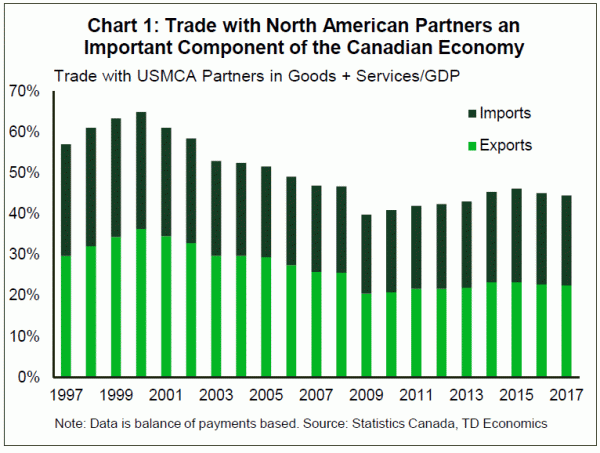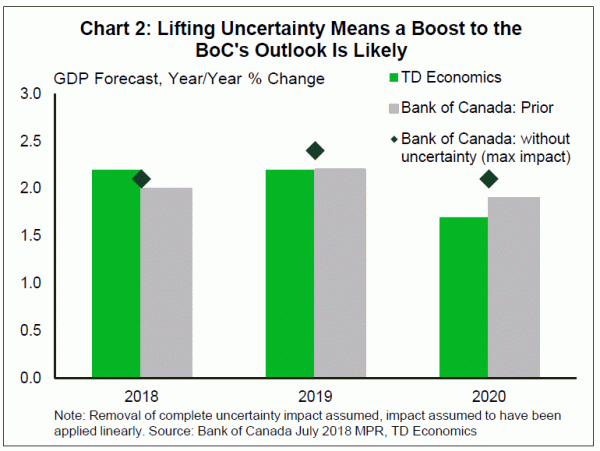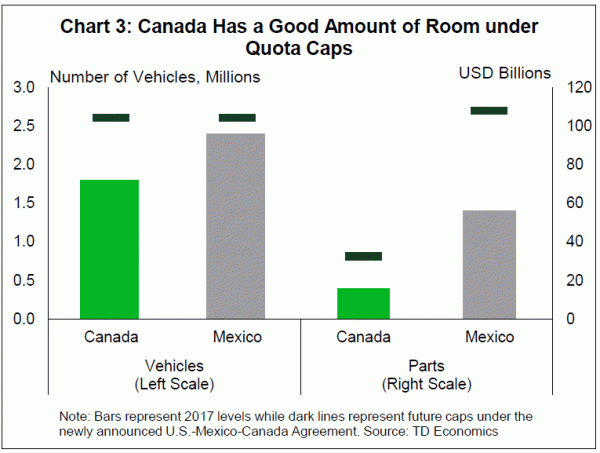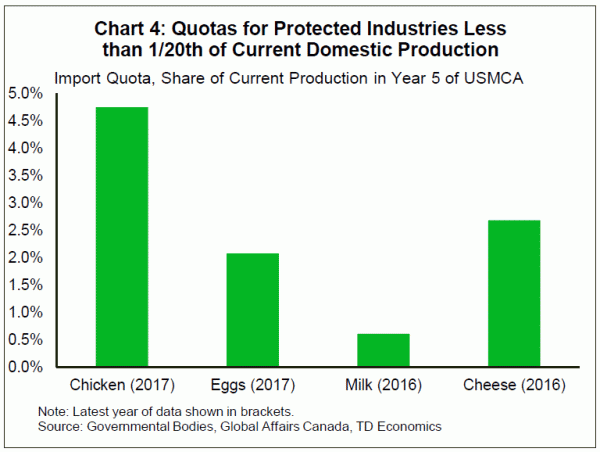Highlights
- The conclusion earlier this month of NAFTA renegotiations with the creation of new U.S. Mexico Canada Agreement (USMCA) removes the cloud of uncertainty hanging over exports and investment.
- For the Bank of Canada, the result is likely to be an improved economic outlook, and thus a tilt in the balance of risks towards a slightly faster pace of interest rate hikes than we had pencilled in prior. Financial markets appear to have incorporated this information, as market pricing for future rate hikes moved up markedly in the wake of the agreement.
- As with all trade agreements, while the aggregate result should be positive for the economy, the benefits are unlikely to be evenly distributed.
- Among those benefitting the most are consumers, who should see increased purchasing power partly reflecting higher ‘de minimis’ thresholds, and the auto/parts sector, which have avoided the threat of steep tariffs. Indeed, changes to rules of origin and other requirements largely dovetail with existing Canadian production patterns.
- Protected agricultural industries, such as dairy, will see a further opening up of domestic markets to foreign competition. The federal government has already indicated that compensation is forthcoming.
- If there are soft spots it is that U.S. steel and aluminum tariffs remain in place, and that the process of negotiation itself may have resulted in some scarring of business investment. On the former, there is still hope that these widely unpopular tariffs that present a cost burden for U.S. auto manufacturers (among others) may be lifted given the new agreement.
After what often felt like interminable rounds of back and forth, a refreshed NAFTA, now called the U.S. Canada Mexico Agreement (USMCA) was finally reached on September 30th, subject to legislative passage by the three national governments. Much in the new agreement was as expected, with auto rules that largely mimic those agreed over the summer in U.S.-Mexican bilateral negotiations, a modest opening up of Canadian dairy and poultry markets, and the preservation of ‘Chapter 19’ dispute panels for resolving anti-dumping complaints.
While far from perfect, the USMCA is likely to be at least marginally growth positive for Canada’s economy. Most important is that 1) the sizeable economic benefits already realized from the existing agreement have been preserved, and 2) the cloud of uncertainty that has hung over exports and business investment has been lifted. With the agreement touching on nearly all sectors of the highly integrated North American economy, there is much to unpack. This report dives into what the implications are for key Canadian industries.
Biggest USMCA win is USMCA
Starting from a very high level view, a significant focus during negotiations had been on what would have been lost were NAFTA ‘ripped up’. The importance of the trading relationship to Canada is difficult to understate: the U.S. and Mexico represent more than 75 cents of every export dollar. Indeed, the original NAFTA agreement has generated a significant economic benefit for Canada, on the order of $50bn per year (roughly 2.4% of GDP) – unsurprising given the close geographic proximity and sheer size of these markets.1
The greatest single benefit of the agreement is that it removes a dark cloud that has been overhanging the Canadian economy. The cost of uncertainty is, of course, hard to quantify, as we’ll never know what economic growth would have been absent this impact. The Bank of Canada has taken a stab at it, quantifying the lost output due to the uncertainty factor at about 0.5% over 2017Q4 to 2020Q4.2 Thus, reversing this effect is a net positive to Canada’s growth rate. This lift comes not from any particular aspect of the agreement, but instead from the rewards of increased trade certainty, to business investment and exports.3 It is telling of the importance of trade with the U.S. and Mexico that the Bank of Canada’s estimates of uncertainty impacts alone are larger than the 0.2% to 0.4% of GDP gained by the Comprehensive and Progressive Agreement for Trans-Pacific Partnership (CP-TPP) and the Canada-EU Comprehensive Economic and Trade Agreement (CETA) respectively.4,5
In contrast to the Bank of Canada, TD Economics expects only a modest impact on near-term growth thanks to the conclusion of negotiations. This difference is likely due to differing treatments of negotiations. We have always incorporated a successful conclusion in our forecasts, with a lifting of uncertainty to match. By contrast, the Bank of Canada typically does not include changes to laws/regulations until they are in effect (or reasonably likely to be). Regardless of this difference, we are likely to be in agreement that removing this uncertainty can only be a good thing for the Canadian economy.
Investment the asterisk
If there is a significant unknown in the wake of USMCA, it is the degree to which the past year’s events have impacted investment sentiment. Lifting immediate uncertainty is a positive, but there is another counterfactual that must be considered: what would investment and thus economic growth (and their outlooks) look like had we never gone through the negotiation process? We, and, it doesn’t seem like a stretch to say, likely the Bank of Canada, would be pencilling in stronger numbers than would otherwise be the case. That a long-standing trade relationship can be unilaterally thrust into re-negotiation, with tariff threats along the way, calls to question the reliability of the global trading system, or at least one country in it.
Moreover, as will be discussed further, while many aspects of USMCA are better than the alternative, they are still not overwhelmingly positive, particularly when compared with NAFTA. The ‘6/16’ year structure for potential re-negotiation is better than the five year forced negotiation threat, but does not eliminate uncertainty over all investment horizons. So, it is conceivable that some ‘scarring’ of investment may have resulted from the past year’s events, and, relative to NAFTA, USMCA is unlikely to incent the same (or more) investment going forward.
Less uncertainty = more breathing room for BoC
Still, even if the potential for scarring means that the addition of the full half-point lift to GDP by the Bank of Canada may be optimistic, an upgrade to the outlook appears likely. At the upper end, this could be enough to move the Bank of Canada’s growth forecast to as high as 2.4% for 2019 (Chart 2).6 Again, with U.S.-centered trade uncertainty far from resolved, and the past year’s events in mind, this would be a best-case scenario. But at least some upgrade is likely, and the balance of risks around the outlook have shifted. We expect this, together with near term economic growth that is exceeding their expectations, to translate into a slightly more hawkish tone from the Bank of Canada to accompany a likely hike of its policy interest rate later this month. As discussed in our initial commentary, the economic fundamentals suggest that there is now a greater probability of three more rate hikes next year (we currently assume two hikes).
We are not alone in this view. Markets sent the loonie rallying to about 78 U.S. cents in the wake of the agreement. Although it has since pulled back due to strength in the greenback, the Canadian dollar has strengthened against other major currencies since USMCA was announced. If the U.S. dollar loses some of its lustre, the loonie could reach its fair value of 80 cents in the coming months. Similarly, futures markets went from pricing in two rate hikes in 2019 with virtually no likelihood of a third, to a roughly 40% pricing of three hikes next year.
The nitty gritty: sectoral implications
Three areas dominated headlines during negotiations: the auto sector, the dairy sector, and dispute resolution. On the first, the template of the U.S.-Mexican bilateral agreement reached this summer has been extended to cover Canada. Local content requirements will be higher, at about 75% of a vehicle (versus roughly 63% before). There are also requirements regarding wages paid in production plants (40% of content must come from plants paying at least $16/hour) and sourcing of raw metals (70% must come from partner countries). These new rules will be phased in over a few years. Neither of these requirements seems to be a major challenge for the Canadian auto industry in its current form, although proving that products meet all of these requirements may be time consuming. Also matching earlier precedent is the introduction of a quota for Canadian auto products entering the U.S., a discouraging development on its face. Fortunately, the devil is in the details here as well, in a positive way. Based on U.S. documents, the quota will apply only to products that do not conform to the new requirements, and guarantees a relatively low tariff of 2.5% for non-conforming products up to this cap. What’s more, with the quota set at 40% above current levels, it will likely be some time before this becomes a significant issue (Chart 3) even if all production is non-conforming (again, indications are that by and large, Canadian production already meets the new requirements).
On the highly contentious dairy sector, it appears that Canadian agreements with Europe and Asian economies (CETA and CPTPP) are the lodestars. Approximately 3.6% of the Canadian market will be opened up, and other fig leaves are on offer. Changes to product classifications – notably the Class 7 product pricing system, the seeming source of ire related to ‘ultrafiltered’ milk and other industrial products – will be rolled back, re-opening the door for American producers.
The poultry sector also faces changes. Imports of approximately 57k tonnes of U.S. chicken is permitted after five years, an increase of about 12k tonnes from prior levels, a small share of the roughly 1.2 million tonnes of domestic chicken production in 2017 (Chart 4 –note that the shares shown are the net changes due to USMCA only). This brings total allowable imports to about 11% of Canadian production, including the impact of the CP-TPP and CETA agreements – similar to the cumulative impacts on the dairy sector. On top of this, starting from the seventh year of the agreement, chicken access will expand one percent per year over a decade. Additionally, imports of 10 million dozen eggs above current levels will be allowed in the first year of the agreement, with egg access also growing by one percent per year over the next 10 years. As has been precedent in other trade agreements, the Federal government has already indicated that compensation for those affected will be forthcoming. For other agricultural sectors, such as grains, beef, and pork, it is by and large business as usual given that these producers were already competing on level ground with their global counterparts.
On the retail front, shoppers north of the border will have more options for small online purchases as the ‘de minimis’ threshold, or the value below which imports are not subject to duties, has been expanded from its current level of $20, to $150. This brings the Canadian level closer to international norms. The Canadian retail sector has been surprisingly sanguine in response to this change, owing to an important detail. Although duties will not be required for purchases under $150, these duties are quite low, on the order of 2% of the total value. The bigger risk, from the sector’s point of view, was sales taxes, which will continue to be assessed for purchases above a much more modest threshold of $40.
Dispute panels largely kept in place
Canada was reported to have fought hard to preserve dispute resolution panels, notably the Chapter 19 panels that adjudicate over claims of dumping. These panels will, by and large, be preserved, now included as Chapter 10 of the USMCA. These mean that the signatories retain the ability to challenge any potential anti-dumping or countervailing duties via an independent panel of judges. The ability to enforce the terms of the agreement (Chapter 20 in NAFTA) has also been maintained.
The major change on this front was the elimination of the NAFTA Chapter 11 dispute mechanism. This allowed for companies to sue governments if they believe they were being mistreated. This is completely eliminated for Canada, and remains in effect for a handful of key Mexican industries. Notably, scrapping this mechanism was a key U.S. demand despite U.S. firms being frequent complainants under the old system. Going forward, any complaints against partner governments by Canadian firms will necessitate the Canadian government getting involved.
Still waiting on steel and aluminum
A clearly disappointing outcome is that the USMCA did not come with any change to U.S. tariffs on steel and aluminum (and by extension, Canadian retaliatory tariffs). For the time being, these tariffs remain in place, although it remains the case that with widespread opposition in all three countries and a revamped auto sector agreement (a major user of these products), a wind-down of the tariffs may still be possible.
Sunsets, fortunately, look far away
A sunset clause, from a Canadian (and Mexican) perspective, was to be avoided. After all, how much uncertainty are you truly lifting with an agreement if you’re going back to the negotiating table in just a few years’ time? Unfortunately, this was a major point of contention from an American perspective, which means that some sort of sunset process would likely have to be reached. Fortunately, the clause that has been agreed is not onerous. The agreement functions in 16 year increments, with the option to meet six years in to each ‘window’ to extend it a further 16 years. While not ideal, this length dovetails much better with investment decisions than, say, a five year mandatory renegotiation process, which had reportedly been proposed. It is also notable that the USMCA replaces NAFTA, rather than superseding it. This means that should the agreement be dissolved, there would be no ‘fallback’ agreement, whereas the dissolution of NAFTA would have meant a reversion to the CUSFTA.
Other aspects: longer copyrights, no movement on procurement
Given the size and details of the USMCA, it is challenging to report on every aspect. Beyond the major areas already discussed, the agreement also changed copyright protections, adding an additional 20 years of protection after the creator’s death (to 70 years, bringing Canada in line with U.S. and E.U. protections). New biologic drugs (an important, emerging class of products that are not typically produced through chemical synthesis) will receive 10 years of protection from generic competition, 2 years higher than Canada had previously agreed to.
Within the energy sector, a U.S. tax on diluent, a chemical which makes it easier for heavy oil products to flow through pipelines, will be eliminated so long as the diluent content represents less than 40% of the volume of a shipment, helping, at least marginally, to improve Canadian oil price competitiveness. The ‘proportionality clause’ is also gone. This had required that any reduction in energy exports to the U.S. had to be accompanied by reductions in production for Canadian domestic use; its elimination should provide Canadian producers with more flexibility in allocating product to various markets.
Government procurement regulations were by and large left unchanged. This is in contrast to CETA, where Canadian firms will be able to bid for European government contracts. Regarding the environment, USMCA moves environmental provisions into the agreement, rather than sitting in a separate agreement as had been the case prior. Beyond this change though, the provisions are largely what already existed in NAFTA. The USMCA also includes a clause restricting governments from requiring local computer data storage as a condition of doing business.7 The digital provisions also bar governments from prohibiting or restricting the cross-border movement of electronic data.
Also left largely unchanged was the NAFTA visa system (often referred to as ‘TN Visas’ after the corresponding U.S. visa code). Perhaps most surprising is that the list of covered occupations was left unchanged – labour markets have continued to evolve since this list was first generated in the early 1990s. Although the bulk of the text was left unchanged, a tweak in USMCA creates the path for countries to set numeric limits, a very different outcome from agreements such as CP-TPP and CETA.
U.S. looking over our shoulder (And us theirs)
Beyond the updates (or lack thereof) to individual trade areas, a big surprise came from the inclusion of a clause regarding negotiations with ‘non-market countries’. Any USMCA country that enters free trade negotiations with such a country – China being the obvious example – must notify the other members and allow them to review any deal’s text. The partner countries are then allowed to serve six month’s notification that they plan to force that country’s exit from USMCA (i.e. USMCA becomes a bilateral agreement between the other two countries), echoing provisions elsewhere in the agreement, and indeed NAFTA. This clause has been widely interpreted as a move by the U.S. to further pressure China in the context of their current trade dispute. Canada’s agreement to this provision may be an indication that a free trade agreement with
China is unlikely to be reached in the next six years or so.
USMCA also includes provisions related to macroeconomic policies (Chapter 33). This includes general commitments to free floating exchange rates, as well as timely reporting of currency holdings, FX interventions, and similar actions, both in terms of data, as well as in the literal sense (i.e. notifying partners in the event of a currency intervention). A ‘Macroeconomic Committee’ will be established to monitor members’ commitments in this regard. This committee will have the ability to alter the provisions of USMCA, if needed in light of economic conditions. Notably, any changes are to be based on a consensus agreement, which should help maintain a level playing field in assessing economic policies. On balance, given all three countries already have floating currencies and meet the chapter’s reporting requirements, this provision seems more like an insurance policy for the future than anything else.
Bringing it together: the winners and losers
As with any trade agreement, a positive aggregate outcome masks a range of outcomes by sector. If there is one clear winner, it is Canadian consumers. USMCA brings more competition into a variety of markets, and so should help expand purchasing power, particularly for consumer staples. Consumers also benefit from the change in de minimis thresholds for low value purchases from abroad. A clear beneficiary are supply chain audit specialists – the complicated rules governing the auto sector should generate demand for compliance audits.
That brings us to the industries that fall somewhere in between. Canadian auto and parts manufacturers will see their near-term competiveness relative to their Mexican counterparts improve, although, as noted, verification costs to achieve duty-free treatment are likely to rise. The medium-term picture is a bit muddier, with new requirements potentially reducing North American competitiveness vs. other jurisdictions. Also falling somewhere in the middle are Canadian retailers, which are unlikely to be pleased by the threshold for tax-free imports rising, but this pain is surely blunted by the fact that the tax-free and duty-free thresholds remain relatively low by international standards.
Clearly on the other side of the scale are the dairy and poultry sectors. USMCA further impinges on the protections in place for these industries. If past agreements are any indication however, government compensation will likely be on offer to ease the pain. That brings us to taxpayers, who will ultimately pay this compensation. This fact must be balanced against longer-term gains in purchasing power. On top of this, changes to patent protections for medicines may incent additional R+D, but comes at the cost of higher purchasing costs both via private insurance plans, as well as public systems. Similarly IP changes should boost Canadian content producers, while raising costs for some users, such as libraries.
Bottom line
The USMCA brings a conclusion to a worrying time for Canadian businesses. Although the resolution will do little to alter TD Economics’ forecast of the Canadian economy, it will likely provoke an upgraded outlook from the Bank of Canada. This tilts the balance of risks towards a faster pace of interest rate increases than previously assumed. As with all trade agreements, benefits are unlikely to be shared equally across all groups. Consumers come out on top, although taxpayers will be on the hook for likely compensation of the agricultural sector. The auto sector also benefits from the removal of tariff threats and new rules of origin that they largely already meet, although new content rules will deliver an offsetting hit to medium-term competitiveness. Most importantly, Canadians can breathe a collective sigh of relief as a measure of certainty is restored to our most important trading relationship.
End Notes
- See Hufbauer et. al, 2014: https://piie.com/sites/default/files/publications/briefings/piieb14-3.pdf
- It is always important to remember that as is often the case, although the agreement is beneficial to the economy as a whole, not all individuals/industries stand to gain from these changes, as will be explored further in this report.
- See Box 1 of the Bank of Canada’s July 2018 Monetary Policy Report: https://www.bankofcanada.ca/2018/07/mpr-2018-07-11/
- See http://international.gc.ca/trade-commerce/trade-agreements-accords-commerciaux/agr-acc/cptpp-ptpgp/impact-repercussions.aspx
- Source, PBO, with impacts adjusted to 2017 figures. See http://www.pbo-dpb.gc.ca/web/default/files/Documents/Reports/2017/CETA/CETA_EN.pdf
- The drag on growth from uncertainty on U.S. trade policy was unlikely to have been driven by NAFTA renegotiations alone. With U.S.-China trade tensions still high and USMCA not legislated, the Bank of Canada may be cautious in removing all of the assumed growth impacts. This analysis also assumes that the uncertainty impacted the outlook in a linear fashion – the Bank of Canada has not provided any guidance regarding the distribution of the impacts over their forecast.
- In the context of financial services, an important clarification is that the Canadian government will allow non-localized storage for foreign firms (i.e. schedule 2 and 3 banks), with localization requirements for schedule 1 banks remaining as is. Any future changes will be the purview of domestic laws/regulations.
















